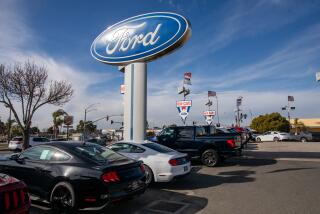Stretched car loans gain traction with buyers
Scott Greenberg could have handled a bigger car payment.
But with a baby on the way and the dealership offering a rock-bottom interest rate, Greenberg stretched the loan to 72 months — about as long as the average American keeps a new car. At 2.64% interest, the long term cut about $100 from his monthly payment on the Volkswagen Touareg SUV.
“I will be putting that savings into her college fund,” Greenberg said of the daughter he’s expecting.
The Santa Monica technology consultant is among a record number of car buyers taking out loans of six, eight or even 10 years. Loans of six years or longer account for 30% of all financing deals so far this year, including leases, according to research firm J.D. Power and Associates. That’s up from 23% five years ago.
The standard length of car loans — once four years, then five — has been creeping up for some time. Extended terms are gaining traction in an era when cars last longer and have better warranties. Automakers have marketed the long loans aggressively, persuading some buyers to move up to pricier models they couldn’t otherwise afford. The median-priced new car now costs $28,555, according to Kelley Blue Book.
“Someone who really has the budget for a Corolla figures if they extend the financing out, they can buy a Camry,” said James Lentz, chief executive of Toyota Motor Corp.’s North American division.
It’s the kind of trend that normally makes personal finance gurus sound the alarm. And long loans can still get consumers in trouble, particularly those with tarnished credit who can’t qualify for the best deals. But at historically low rates, longer loans can make sense for savvy buyers with good credit and the intent to drive their vehicles for many years. Such consumers are slashing their car payments and diverting the money to higher-interest debt, investments or other priorities.
Bradley Gallant of Plymouth, Mich., plans to divert extra money each month to investments. He borrowed for 72 months at 1.89% from Wells Fargo when he bought a Honda Accord in March. The finance executive at an energy company slashed about $130 from his monthly payment compared with the traditional four-year loan. He’ll shell out only about $370 more in interest over the life of the loan.
“I am confident I could invest the cash in alternative investments and earn a much higher return,” Gallant said.
Although interest rates on home mortgages have started to rise, analysts believe the low rates on auto loans should stick around for some time. Automakers are often more concerned with selling cars than profiting from financing.
“Low finance rates are what is keeping America spending,” said Jessica Caldwell, an analyst at auto information company Edmunds.com.
Automakers make more in interest on longer loans, with little additional risk. Car loan defaults typically take place within six months after purchase, when the car still has much of its value, Lentz said.
Consumer finance experts warn that longer loans work only because of the rock-bottom interest rates — and even then, they should be approached with caution.
“It’s treating a car like a home mortgage,” said Casey Bond, managing editor of GoBankingRates.com, a personal finance information company. “You really have to do the math. Personally, I don’t like paying extra money for the privilege of being in debt.”
Even at low rates, it’s not smart to use debt for purchases that don’t fit your budget, she said.
“My suggestion would be to buy a cheaper car,” Bond said.
Car shoppers pursuing a long loan need to have stellar credit and financial reserves, said Christopher Kukla, senior vice president of the Center for Responsible Lending.
They’ll need cash for a replacement vehicle if their car gets totaled, because longer loans and smaller payments leave drivers vulnerable to owing more than the insurance company will pay on a claim, Kukla said.
Otherwise, they can quickly find themselves in the financial quagmire that caught Gilberto Chacin, a U.S. Army sergeant at Fort Irwin, the sprawling base in the Mojave Desert.
Chacin bought a 2013 Mazda CX-5 after an aging Dodge Caravan became unreliable. He had to take out an 84-month loan to get the monthly payment down to a manageable $469. That’s because he still owed $5,000 on the old van and had to wrap that debt into the new 6.1% loan.
“I never intended to pay for a car for 84 months. We understand that it is a horrible financial decision,” Chacin said. “Sometimes life throws curveballs at you.”
Long car loans make the decision of what car to buy that much more important. Cars with a track record of strong reliability and resale value are less likely to leave buyers in a lurch.
Consider the buyer of a $26,000 Chrysler 200, which has one of the worst resale values among family sedans. That car’s value would probably plummet to about $10,600 after just three years, according to ALG, an auto research firm that analyzes resale values. The buyer would still owe at least $1,000 more than that on a six-year loan at 2% interest, assuming a $4,000 down payment.
The same scenario would enable the buyer of a similarly priced Honda Accord — with among the best resale values — to sell the car for $3,000 more than what was owed. Even at 6% interest, the Accord buyer would come out about $1,500 ahead after three years.
Another big problem with long loans, experts say, is that only a small percentage of buyers qualify for the lowest interest rates, which lenders aggressively market to all shoppers.
“Most people with subprime credit are happy someone said yes,” Kukla said, “and they buy almost solely on monthly payment.”
That’s what happened to Lisa Gregg, an administrative assistant in Nashville. After her car was totaled in a wreck, Gregg bought a new Kia Rio, financing the entire $17,322 purchase price. Because of her credit problem, the dealer gave her a six-year loan with a 16.99% interest rate.
Gregg will pay more than $10,000 in interest over the life of the loan — almost enough to buy another small economy car. She’s now looking to refinance the car at a lower rate.
“Like most people, I looked at the monthly payment rather the total, and the longer term had a lower payment,” Gregg said. “It is my own fault, but I needed a car.”








